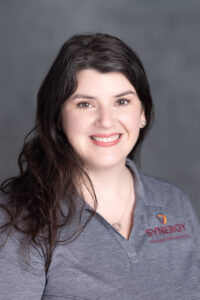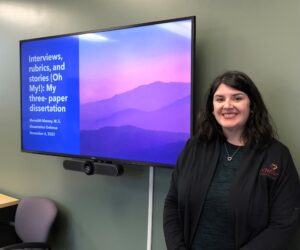By Meredith Massey, Ph.D.
Who I am

Greetings! I’m Dr. Meredith Massey. I finished my PhD in Evaluation, Statistics, and Methodology (ESM) at UTK in the Fall of 2023. In addition to my PhD in ESM, I also completed graduate certificates in Women, Gender, and Sexuality and Qualitative Research Methods in Education. While I was a part-time graduate student, I also worked full-time as an evaluation associate at Synergy Evaluation Institute, a university-based evaluation center. By day, I worked for clients evaluating their STEM education and outreach programs. By night, I was an emerging scholar in ESM. During my time in the program, my research interests grew to include andragogical issues in applied research methods courses, classroom measurement and assessment, feminist research methods, and evaluation.
How my dissertation came to be
In the ESM program, students can choose to complete a three-manuscript dissertation rather than a traditional five-chapter dissertation. When it came time to start deciding what my dissertation would look like, my faculty advisor, Dr. Leia Cain, suggested I consider the three-manuscript option. As someone who has varied interests, this idea appealed to me because it allowed me the flexibility to work on three separate but related studies. My dissertation flowed from a research internship that I completed with Dr. Cain. I interviewed qualitative faculty about their assessment beliefs and practices within their qualitative methods courses. I wrote a journal article on that study to serve as my comprehensive exam writing requirement. Using my original internship study as the basis for my first dissertation manuscript was an expedient strategy as it allowed me to structure my second and third manuscripts on the findings of my first study. I presented my ideas for my second and third manuscripts to my committee in my dissertation proposal, accepted their feedback on how to proceed with my studies and then got to work.
Dissertation topic and results
In my multi-paper dissertation entitled “Interviews, rubrics and stories (Oh my!): My journey through a three-manuscript dissertation,” I chose to center faculty and students’ perspectives on assessment and learning. To that end, my first and second research studies both focused on those two issues, while the third paper went further into exploring the students’ perspective through my story of the parallel formations of my scholarly identity and my new identity as a part of a married couple. In the first study, “Interviewing the Interviewers: How qualitative faculty assess interviews,” I reported how faculty use interview assignments in their courses and how they engage with assessment tools such as rubrics for those interview assignments. We learned that the faculty view interview assignments as the best and most comprehensive assignment their students can complete to give them experience as qualitative researchers. Regarding assessment tools such as rubrics, while instructors had differing opinions on whether rubrics were an appropriate tool to use in their assessment practices, all the instructors believed that giving students feedback was an essential assessment practice. My findings in that manuscript helped shape the plan to implement the second study. In “I can do qualitative research: Using student-designed rubrics to teach interviewing,” I detailed testing out an innovative student-created rubric for an interview assignment in an introductory qualitative research methods course and used student reflections as the basis for writing an ethnodrama about how students experience their first interview assignments and how they engaged with their rubric. From this study, we learned that students grew in their confidence in conducting interviews, experienced a transformation in their paradigm, and were conflicted about using the student-designed rubric in that some students found it useful, and some did not. Both manuscripts informed my third manuscript, an autoethnography detailing the parallel transitions in my identity from an evaluator to a scholar and my identity from a single person to a married person. I wrote interweaving stories chronicling the parallels between the similar and contrasting methods I use as an evaluator and researcher, how this tied into my growing identity as a scholar, and the similarities and contrasts of how I’ve noticed my identity has been changing throughout my engagement and being newly married to my longtime boyfriend, now husband. These studies contributed valuable knowledge to the existing, though limited, andragogical literature on qualitative research methods. My hope going forward is that qualitative faculty continue this focus, beginning conversations about their classroom assessments to complete their own andragogical studies determining the impact of their teaching on their students’ learning.

What’s next?
Now that I’m finished with my dissertation and my studies, I am happy to report that I have accepted a promotion at my job at Synergy Evaluation Institute, and I’ve also been given the opportunity to teach qualitative research methods courses as an adjunct in the ESM program. I’m excited to continue being associated with the program and teach future ESM students. Being in the ESM program at UTK, while difficult at times, has also been a joy. The ESM program encouraged me to explore my varied interests and ultimately supported me as I grew professionally as an evaluator and scholar. The program accommodated and respected me as a working professional, and I highly recommend the program to any student with an interest in working with data as an evaluator, assessment professional, statistician, qualitative researcher, faculty, or all of the above. There’s a place for all in ESM.
Resources
Journal article citation
Massey, M.C., & Cain, L.K. (In press). Interviewing the interviewers: How qualitative faculty assess interviews. The Qualitative Report.
Books specifically about Qualitative Research Methods Andragogy
Eisenhart, M., & Jurow, A. S. (2011). Teaching qualitative research. In N. K. Denzin & Y. S. Lincoln (Eds.), The SAGE handbook of qualitative research (4th ed., pp. 699-714). Sage.
Hurworth, R. E. (2008). Teaching qualitative research: Cases and issues. Sense Publishers.
Swaminathan, R., & Mulvihill, T. M. (2018). Teaching qualitative research: Strategies for engaging emerging scholars. Guilford Publications.
Books to read to become familiar with Ethnodrama as a method
Leavy, P. (2015). Handbook of Arts-Based Research (2nd ed.). The Guilford Press.
Leavy, P. (2018). Handbook of Arts-Based Research (3rd ed.). The Guilford Press.
Saldana, J. (2016.) Ethnotheatre: Research from page to stage. Routledge. http://doi.org/10.4324/9781315428932
Most useful citations to become familiar with autoethnography as a method
Cooper, R., & Lilyea, B. V. (2022). I’m Interested in Autoethnography, but How Do I Do It?. The Qualitative Report, 27(1), 197-208. https://doi.org/10.46743/2160-3715/2022.5288
Ellis, C. (2004). The Ethnographic I: a methodological novel about
autoethnography. AltaMira.
Ellis, C. (2013). Carrying the torch for autoethnography. In S. H. Jones, T. E. Adams., and C. Ellis (eds.) Handbook of Autoethnography (pp. 9-12). Left Coast Press.